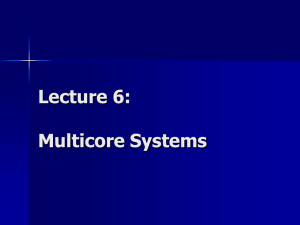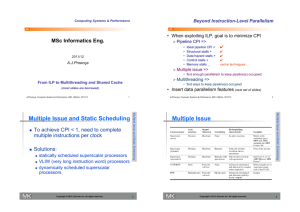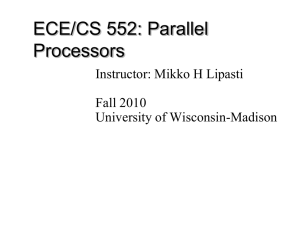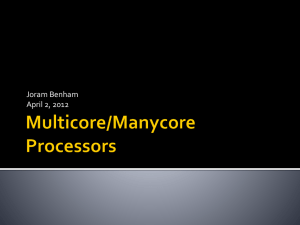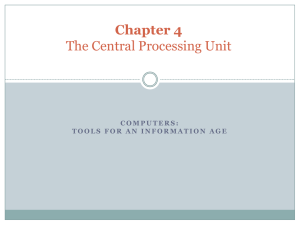PPT
advertisement
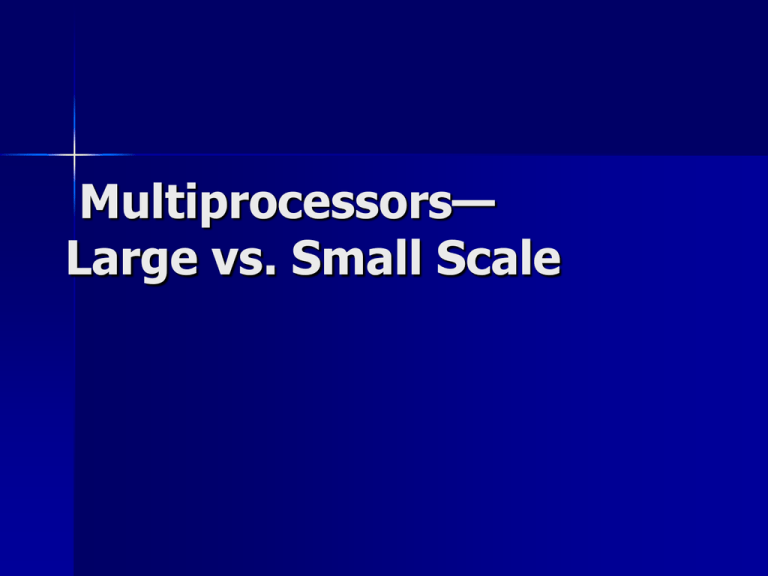
Multiprocessors— Large vs. Small Scale Small-Scale MIMD Designs Memory: centralized with uniform memory access time (UMA) and bus interconnect Examples: SPARCcenter Large-Scale MIMD Designs Memory: distributed with non-uniform memory access time (NUMA) and scalable interconnect Examples: Cray T3D, Intel Paragon, CM-5 Communication Models Shared Memory – Communication via shared address space – Advantages: Ease of programming Lower latency Easier to use hardware controlled caching Message passing – Processors have private memories, communicate via messages – Advantages: Less hardware, easier to design Focuses attention on costly non-local operations Communication Properties Bandwidth – Need high bandwidth in communication – Limits in network, memory, and processor Latency – Affects performance, since processor wait – Affects ease of programming - How to overlap communication and computation. Latency Hiding – How can a mechanism help hide latency? – Examples: overlap message send with computation, prefetch Small-Scale—Shared Memory Caches serve to: – Increase bandwidth versus bus/memory – Reduce latency of access – Valuable for both private data and shared data What about cache consistency? The Problem of Cache Coherency Value of X in memory is 1 CPU A reads X – its cache now contains 1 CPU B reads X – its cache now contains 1 CPU A stores 0 into X – CPU A’s cache contains a 0 – CPU B’s cache contains a 1 Multicore Systems Multicore Computers (chip multiprocessors) Combine two or more processors (cores) on a single piece of silicon Each core consists of ALU, registers, pipeline hardware, L1 instruction and data caches Multithreading is used Pollack’s Rule Performance increase is roughly proportional to the square root of the increase in complexity performance √complexity Power consumption increase is roughly linearly proportional to the increase in complexity power consumption complexity Pollack’s Rule complexity power performance 1 1 1 4 4 2 25 25 5 100s of low complexity cores, each operating at very low power Ex: Four small cores complexity power performance 4x1 4x1 4 Increasing CPU Performance Manycore Chip Composed of hybrid cores • • • Some general purpose Some graphics Some floating point Exascale Systems Board composed of multiple manycore chips sharing memory Rack composed of multiple boards A room full of these racks Millions of cores Exascale systems (1018 Flop/s) Moore’s Law Reinterpreted Number of cores per chip doubles every 2 years Number of threads of execution doubles every 2 years Shared Memory MIMD P P P P Shared memory Bus • Memory • Single address space All processes have access to the pool of shared memory Shared Memory MIMD CU PE data CU PE data CU PE data CU PE instruction Memory data Each processor executes different instructions asynchronously, using different data Symmetric Multiprocessors (SMP) Proc Proc L1 L1 … L2 L2 System bus Main Memory I/O I/O I/O MIMD Shared memory UMA Symmetric Multiprocessors (SMP) Characteristics: Two or more similar processors Processors share the same memory and I/O facilities Processors are connected by bus or other internal connection scheme, such that memory access time is the same for each processor All processors share access to I/O devices All processors can perform the same functions The system is controlled by the operating system Symmetric Multiprocessors (SMP) Operating system: Provides tools and functions to exploit the parallelism Schedules processes or threads across all of the processors Takes care of • • scheduling of threads and processes on processors synchronization among processors Multicore Computers CPU core 1 L1-I L1-D L2 Main Memory CPU core n … L1-I L1-D I/O I/O I/O Dedicated L1 Cache (ARM11 MPCore) Multicore Computers CPU core 1 L1-I L1-D L2 CPU core n … L1-I L1-D L2 I/O Main Memory I/O I/O Dedicated L2 Cache (AMD Opteron) Multicore Computers CPU core 1 L1-I L1-D CPU core n … L1-I L1-D L2 I/O Main Memory I/O I/O Shared L2 Cache (Intel Core Duo) Multicore Computers CPU core 1 L1-I L1-D CPU core n … L2 L1-I L1-D L2 L3 I/O Main Memory I/O I/O Shared L3 Cache (Intel Core i7) Multicore Computers Advantages of Shared L2 cache Reduced overall miss rate • Thread on one core may cause a frame to be brought into the cache, thread on another core may access the same location that has already been brought into the cache Data shared by multiple cores is not replicated The amount of shared cache allocated to each core may be dynamic Interprocessor communication is easy to implement Advantages of Dedicated L2 cache Each core can access its private cache more rapidly L3 cache When the amount of memory and number of cores grow, L3 cache provides better performance Multicore Computers On-chip interconnects Bus Crossbar Off-chip communication (CPU-to-CPU or I/O): Bus-based Multicore Computers (chip multiprocessors) Combine two or more processors (cores) on a single piece of silicon Each core consists of ALU, registers, pipeline hardware, L1 instruction and data caches Multithreading is used Multicore Computers Multithreading A multithreaded processor provides a separate PC for each thread (hardware multithreading) Implicit multithreading • Concurrent execution of multiple threads extracted from a single sequential program Explicit multithreading • Execute instructions from different explicit threads by interleaving instructions from different threads on shared or parallel pipelines Multicore Computers Explicit Multithreading Fine-grained multithreading (Interleaved multithreading) • • Processor deals with two or more thread contexts at a time Switching from one thread to another at each clock cycle Coarse-grained multithreading (Blocked multithreading) • • Instructions of a thread are executed sequentially until an event that causes a delay (eg. cache miss) occurs This event causes a switch to another thread Simultaneous multithreading (SMT) • • Instructions are simultaneously issued from multiple threads to the execution units of a superscalar processor Thread-level parallelism is combined with instruction-level parallelism (ILP) Chip multiprocessing (CMP) • Each processor of a multicore system handles separate threads Coarse-grained, Fine-grained, Symmetric Multithreading, CMP GPUs (Graphics Processing Units) Characteristics of GPUs GPUs are accelerators for CPUs SIMD GPUs have many parallel processors and many concurrent threads (i.e. 10 or more cores; 100s or 1000s of threads per core) CPU-GPU combination is an example for heterogeneous computing GPGPU (general purpose GPU): using a GPU to perform applications traditionally handled by the CPU GPUs
